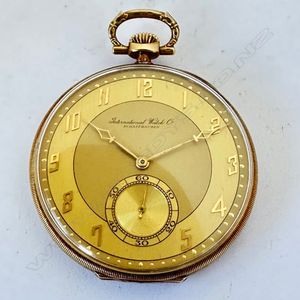IWC Art Deco 14ct Gold Pocket Watch
Art Deco dress style 14ct gold open face pocket watch, by International Watch Co, (IWC) Schaffhausen, number 899499. 50 mm 14ct gold machine engraved case with vacant cartouche to back cover, milled bezels, leaf and berry cast patterned band. Internal 14ct gold dust cover. Swiss assay marks of two squirrels for watch cases from 1880 to 1933 (1). Signed, two tone gold face with Arabic numerals and minute indices, subs seconds dial at 6. Gold hands. IWC stamped and numbered movement with lever escapement, micrometer adjustment. 70gm (1) The German definition of the minimum fineness of 14ct gold is 585', which is slightly finer than Swiss 14ct gold at 0.583', caused a change in Swiss hallmarking of watch cases destined to be exported to Germany. The Swiss case maker struck the German fineness mark in the case.
You must be a subscriber, and be logged in to view price and dealer details.
Subscribe Now to view actual auction price for this item
When you subscribe, you have the option of setting the currency in which to display prices to $Au, $US, $NZ or Stg.
This item has been sold, and the description, image and price are for reference purposes only.
- Movement - The technical name for the workings of a clock or watch, and does not include the dial or case.
- Lever Escapement - A lever escapement is a type of escapement mechanism used in mechanical clocks and watches to regulate the timekeeping of the movement. It was invented by British clockmaker Thomas Mudge in the 18th century and is now widely used in modern mechanical timepieces.
The lever escapement consists of three main parts: the escape wheel, the pallet fork, and the lever. The escape wheel is a wheel with teeth that is driven by the clock or watch's main spring or weight. The pallet fork is a two-pronged component that is positioned so that it can engage with the teeth of the escape wheel, and the lever is a small, L-shaped component that is attached to the pallet fork.
When the escape wheel turns, one of its teeth pushes against one of the pallet fork's prongs, causing the fork to pivot. As the pallet fork pivots, it releases the tooth and engages with the next tooth on the opposite side of the escape wheel. At the same time, the lever, which is connected to the pallet fork, rocks back and forth, allowing the escape wheel to turn at a regulated rate.
The lever escapement is prized for its accuracy and reliability and is commonly used in high-end mechanical watches. It allows for precise timekeeping by ensuring that the movement of the watch or clock is regulated and consistent, and its compact size makes it an ideal choice for use in small, portable timepieces. - Cartouche - An ornamental panel in the form of of a shield, oval or rectangular scroll with curling edges. It may be carved into the back of a chair or the top of a sideboard, or present on a piece of silver or jewellery, and contain the initials of the original owner, heraldic symbols, or some other inscription, such as the details of a presentation.
In ceramics the term defines the central area of a vase or similar with a decorative border in one of the shapes above, into which a decorative scene or figures have been painted. - Art Deco Period - The Art Deco period was a cultural movement that emerged in the 1920s and 1930s, and was characterized by its emphasis on modernism, luxury, and elegance. The name "Art Deco" comes from the Exposition Internationale des Arts Décoratifs et Industriels Modernes, a large exhibition held in Paris in 1925 that showcased the latest trends in decorative arts.
Art Deco was a reaction against the ornate and elaborate styles of the previous era, and reflected a new modern sensibility. It was characterized by streamlined, geometric shapes, bright colours, and the use of new materials such as chrome, glass, and Bakelite. Art Deco designers sought to create a sense of luxury and sophistication, often incorporating expensive materials such as ivory, marble, and rare woods.
Art Deco had a significant impact on a wide range of artistic fields, including architecture, fashion, graphic design, and interior design. Some of the most iconic examples of Art Deco architecture include the Empire State Building in New York City, the Hoover Building in London, and the Palais de Chaillot in Paris.
The Art Deco period came to an end in the 1940s, as World War II and changing cultural trends led to a shift in artistic styles. However, Art Deco remains an important influence on design and art, and continues to be celebrated for its modernist sensibility and glamorous aesthetic. - Assay / Assayed - Assaying is the testing of a metal, most commonly silver and gold to determine its ingredients and quality. In Britain, once an item of silver or gold has been assayed, a mark is stamped on it, certifying its purity. Known as hallmark, it derives its name from the Guild Hall of the Goldsmiths' Company, who recieved its Charter in 1327 giving it the power to assay and mark articles of gold and silver.
This item has been included into following indexes:
